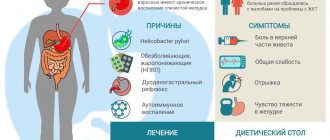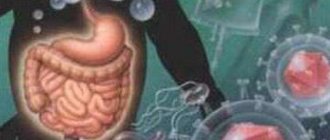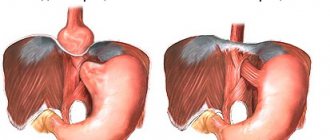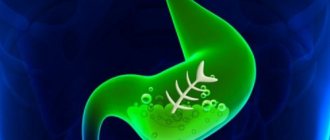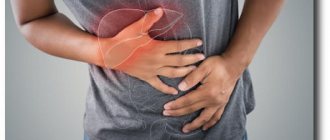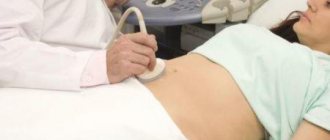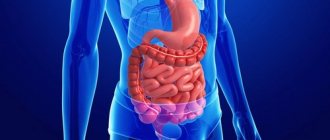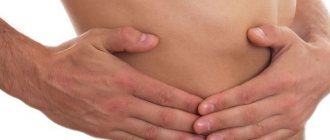Gastrointestinal diseases in adults are often accompanied by motor dysfunction. Duodeno-gastric bile reflux is recorded in approximately half of patients with inflammatory processes in the upper half of the digestive tract. In some cases, changes are isolated. If a patient experiences bile reflux, unpleasant symptoms are observed that cause significant impairment of the condition.
To eliminate clinical manifestations, it is necessary to find out the cause of the pathology and prescribe adequate treatment.
Duodeno-gastric reflux - what is it?
Unpleasant symptoms associated with impaired functioning of the digestive system occur with gastritis, pancreatitis, cholecystitis and other processes.
Duodeno-gastric reflux (DGR) is a pathological condition in which the contents of the duodenum are refluxed into the stomach.
The duodenum contains its own secretion, and the pancreatic ducts and bile ducts open into it.
Three types of secretions mix and participate in the further digestion of the food bolus. Normally they do not rise above the bulb. With reflux, an environment that is aggressive for the overlying organs (stomach and esophagus) moves.
As a result of changes in the motor-evacuation function associated with dysregulation of the sphincters between the stomach and duodenal bulb, stomach and esophagus (through neuro-humoral factors), chemical inflammation develops in these organs. This means that with duodenogastric reflux, reflux gastritis and reflux esophagitis can develop in response to the aggressive effects of bile acids.
The disease is often classified as a group of pathological conditions called gastropathy. These are conditions that are caused by reasons unrelated to Helicobacter pylori infection. But not all experts share this opinion. Because bile reflux can develop as a result of inflammatory diseases caused by the participation of a bacterial pathogen.
Classification
Stagnant processes in the gallbladder and its dysfunction lead to disruption of the process of evacuation of secretions. Bile is released into the intestinal lumen; weakening or improper functioning of the sphincters leads to the release of bile into the higher organs. Duodeno-gastric reflux occurs, which provokes the development of inflammation of the esophagus, gastritis, bulbitis and gastroduodenitis.
Initially, superficial gastritis or erythematous gastropathy occurs. In the absence of treatment with drugs, damage to the deep layers of the mucosa occurs, up to the occurrence of erosive inflammation, and then atrophic gastritis. Therefore, the classification reflects the clinical and morphological aspects of the disease.
Table 1. Classification of DGR
| Categories | Kinds |
| Degrees | The first (weak) - in 50% of patients, reflux of a small amount of contents with minor damage to the mucosa; Second (moderate) - in 10% of patients, the return of bile in larger quantities causes a persistent inflammatory process; Third (pronounced) - regular reflux provokes profound changes and is accompanied by vivid clinical symptoms |
| Type of tissue damage | Superficial - reversible changes in the epithelium; Catarrhal - inflammatory lesion of the upper layers; Erosive - formation of epithelial defects; Biliary - a specific process caused by the influence of bile acids |
| By time of occurrence | Acute Chronic |
What is superficial gastroduodenitis: causes, symptoms, treatment with drugs and folk remedies
Diagnostics
- Fibrogastroduodenoscopy. Using this method, you can identify the presence of bile in the stomach, signs of duodenitis, gastritis, esophagitis, erosion, ulcers and any pathological changes caused by duodenogastric reflux.
- Plain radiography of the stomach and duodenum after contrast. Detects hiatal hernia, tumor formations, esophageal strictures, and so on.
- pH-metry (including daily). It is used to identify changes in acidity in the esophagus and stomach, and helps to assess the duration and number of duodenogastric refluxes.
- Manometry. Used to assess motility and peristalsis of the upper digestive tract.
- Ultrasound examination of the liver, biliary system, pancreas and so on.
Causes
The occurrence of bile reflux is caused by a number of direct and indirect factors. The causes of duodeno-gastric reflux are presented:
- Inflammatory diseases of the gastrointestinal tract - peptic ulcer of the stomach and duodenum, gastritis, gastroduodenitis, pancreatitis.
- Functional lesions - duodenostasis, biliary dyskinesia, insufficiency of the cardia and pylorus.
- Malignant neoplasms of the digestive tract.
- Postoperative conditions. For example, after gastrectomy, gallbladder removal or other types of surgical interventions.
- Treatment with non-steroidal anti-inflammatory drugs that affect sphincter tone.
Indirect causes that play a role in the development of reflux are:
- bearing a fetus during pregnancy;
- stress, psycho-emotional outbursts;
- hernial openings of the diaphragm;
- malnutrition, low-quality and harmful products;
- overweight;
- abnormalities in the development of the digestive organs;
- consequences of violation of the FGDS technique.
Tests and diagnostics
The diagnosis is established on the basis of clinical symptoms and instrumental research methods, among which the most effective are:
- Daily pH-metry - allows you to assess the height of reflux and the profile of intragastric pH.
- Ultrasound diagnostics (echography with water load): with GHD, the retrograde movement of gas and liquid bubbles (corresponding to the reflux of duodenal contents into the stomach) from the pylorus to the body of the stomach is periodically recorded on echograms.
- Transillumination hemomotodynamic monitoring. The difference in motor wave amplitude in the antrum of the stomach and the duodenal bulb is used as a GDR parameter.
- Fibrogastroduodenoscopy (swelling of the coolant, focal hyperemia, pyloric dehiscence).
- X-ray of the stomach (regurgitation of barium from the duodenum into the stomach is noted).
- Fiberoptic spectrophotometry.
If bile reflux is suspected, differential diagnosis is made with acid gastroesophageal reflux and peptic ulcers of the stomach.
Symptoms
It is necessary to treat bile reflux after a comprehensive diagnosis. Activities at the primary stage include identifying clinical signs and causes of the disease.
This gives the specialist the opportunity to clearly differentiate other types of gastrointestinal lesions and symptoms of duodenogastric reflux. To begin treatment, pay attention to the patient’s complaints, which may include:
- Discomfort during or after eating, localized in the epigastric, right hypochondrium and pyloroduodenal area.
- Dyspeptic symptoms - belching with bitterness or acid, bloating, nausea, periodic vomiting with bile, a lump in the throat.
- Changes in the nature of bowel movements - alternating constipation and diarrhea.
- Asthenic syndrome - lethargy, weakness, low ability to work.
- Loss of body weight.
- Anemia.
- Dry skin, hair loss, brittle nail plates.
Diagnostics
Before determining a treatment regimen, it is necessary to examine the patient. Diagnosis of duodenogastric reflux includes an objective examination, anamnesis to determine the cause of symptoms, and instrumental examination.
To make a diagnosis, data from additional methods are important:
- Blood tests - general and biochemical - to assess the performance of the liver, gallbladder, pancreas, and identify signs of inflammation.
- Endoscopy with biopsy - to determine the presence of bile in the stomach, the degree of damage and spread of inflammation, and to exclude pathological formations.
- Tests for identifying Helicobacter pylori - serological, PCR and other options.
- pH-metry - to clarify the acidity of the stomach.
- X-ray examination with contrast - to identify indirect signs of pathology.
- Ultrasound diagnostics - to clarify the condition of parenchymal organs, their structure and size.
Symptoms of duodenogastric reflux
The most indicative symptoms that develop with duodenogastric reflux are:
- stomach ache;
- dyspeptic symptoms;
- flatulence (bloating due to excessive gas in the intestines).
Characteristics of pain with duodenogastric reflux:
- observed in the upper half of the abdomen;
- spilled, do not have a clear localization
- by nature – spastic (spasms in the form of attacks);
- by strength - medium or high intensity;
- occur 30-40 minutes after eating, sometimes earlier (depending on the rate at which food enters the duodenum from the stomach).
Dyspeptic phenomena that occur with this disease are:
heartburn (observed at any level of acidity of gastric contents);- regurgitation (a mini version of vomiting) of food and sour contents;
- belching of air and sour contents;
- as the condition progresses, vomiting mixed with bile contents;
- feeling of bitterness in the mouth.
Why is duodenogastric reflux dangerous?
If signs of bile reflux appear, the doctor is faced with the task of finding the cause of the disease and curing the patient. Unpleasant symptoms that persist over a certain period of time can lead to serious consequences. What is dangerous about duodenogastric reflux is the complications that are presented:
- Gastroesophageal reflux disease - when chyme enters not only the stomach, but also the esophagus, causing damage to the mucous membrane, causing reflux esophagitis.
- Toxic-chemical gastritis with the formation of chronic inflammation of the stomach due to the effect of bile and pancreatic juice on the tissue. It develops if the disease is not treated correctly.
- Adenocarcinoma. Occurs with constant leakage of the contents of the duodenum. Degeneration of glandular cells occurs, which requires radical treatment.
Forecast
The prognosis is favorable in the vast majority of cases. The unfavorable development of duodenogastric reflux occurs due to its neglect and the occurrence of complications. In severe long-term cases, severe disturbances in the motility of the gastrointestinal tract occur, which is fraught with the “loss” of the stomach and duodenum from the normal act of digestion. In such cases, the patient is forced to be fed parenterally (by introducing nutrients through the bloodstream).
Kovtonyuk Oksana Vladimirovna, medical observer, surgeon, consultant doctor
32, total, today
( 71 votes, average: 4.20 out of 5)
Acute dilatation of the stomach in humans: what is it, causes, symptoms and treatment
Chest pain: causes, nature, treatment
Related Posts
Treatment
For bile reflux, comprehensive care is provided. Duodeno-gastric reflux is closely associated with gastritis and gastroduodenitis, insufficiency of the cardia and pylorus of the stomach. Therefore, measures are aimed at eliminating the symptoms and causes of the disease. These include:
- Therapeutic diet.
- Drug treatment regimen.
- The use of physiotherapeutic procedures.
- Physiotherapy.
- Using natural remedies at home.
Important!
Combining different directions increases the effectiveness of therapy and promotes a speedy recovery.
What drugs are used to treat bile reflux?
Drug treatment is the main method of helping patients. Several groups of drugs are used, aimed at the pathogenetic and etiological link of the pathological process, as well as to eliminate symptoms.
Table 2. Recommended groups of drugs for the treatment of duodenogastric reflux
| Kinds | Titles |
| Substances with choleretic action | Kholosas, Ursofalk, Ursosan |
| Prokinetics | Motilium, Domperidone |
| Proton pump inhibitors | Omez, Pantoprazole |
| Antacid medications | Phospholugel, Almagel |
| Antispasmodics, including combined action tablets | Mebeverine, Dicetel, Enterospasmil |
| Analgesics | Buscopan, Paracetamol |
If reflux from the duodenum is associated with Helicobacter pylori infection, antibacterial drugs are prescribed to eradicate the pathogen. If the pancreas and liver are involved in the process - enzyme preparations and others.
Diet and treatment menu
A gentle menu is one of the conditions for the patient’s recovery. Nutrition for duodenogastric reflux is aimed at restoring the normal digestion process, reducing the irritating effect of food on the mucous membrane, and providing the body with nutrients.
Products are recommended to be subjected to heat treatment, which preserves their beneficial properties. This is boiling, stewing, steaming. Take meals at least 5 times a day with short breaks. The last meal should be at least 3 hours before bedtime. Fatty, spicy, fried foods, marinades and canned food, and alcoholic drinks should be excluded. You can eat soups, cereals, steamed vegetables and fruits, jelly, fruit decoctions, tea, yeast-free baked goods, boiled meat.
Physiotherapy
Physical exercise improves motor function and normalizes the digestive process. Therefore, if duodenogastric reflux is diagnosed, physical therapy is recommended by the patient care protocol. You can perform elements of gymnastics.
Table 3. Exercises for GHD
| View | How to do |
| Torso rotations | In a standing position with hands on the belt, turn to the right, then in the opposite direction |
| Torso bends | In a standing position with hands on the belt, bend forward slowly, then return to the starting position |
| Knee pull-up | In a lying position, pull one leg bent at the knee to the stomach, straighten it and repeat the element with the other leg |
| Leg Raising | In a lying position, the straightened legs are raised in turn at a right angle |
Each exercise is done in 3 approaches, slowly, 10 times.
Folk remedies
The gifts of nature have long been used to treat gastrointestinal diseases.
If the patient has duodenogastric reflux, folk remedies can be prescribed along with traditional therapy. For this, infusions, decoctions, tinctures and other products are prepared. Recipes based on:
- lemon balm;
- motherwort;
- licorice root;
- oregano;
- anise;
- mint;
- calendula;
- flax;
- raw potatoes.
Recipe 1
100 grams of flax seeds are ground in a mortar or ground in a coffee grinder. 2 tablespoons of crushed raw materials are poured into 400 ml of boiling water. Bring to a boil and let stand. Strain and drink 0.5 cups 2 hours after eating.
Recipe 2
Mint, oregano and calendula are mixed in equal proportions. 1 tablespoon of herbal mixture is poured into 200 ml of boiling water, infused, and filtered. Add a tablespoon of freshly squeezed Aloe juice and a teaspoon of honey to the warm infusion. Take the drug during the break between meals.
Recipe 3
Fresh potatoes are made from raw potatoes in an accessible way (through a juicer or grated on a fine grater and squeezed). Drink 150 ml of juice on an empty stomach. You can drink the juice 3 times a day. Do not combine with meals.
Attention!
You can use herbs in their pure form or combine several types of plants.
Treatment of duodenogastric reflux
In most cases, patients with duodenogastric reflux are treated on an outpatient basis. Hospitalization in a hospital is carried out:
- for the purpose of a more detailed examination;
- with severe pain and vomiting;
- with the development of complications of this pathology.
Treatment of the disease can be:
- conservative;
- operational.
Conservative therapy is based on:
- normalization of diet and diet;
- normalization of physical activity;
for obesity - normalization of body weight through physical activity and diets selected exclusively by a medical specialist;- giving up coffee;
- stopping smoking and drinking alcoholic beverages (even those with low alcohol content);
- drug therapy;
- physiotherapeutic treatment - taking alkaline mineral waters, abdominal massage.
The basics of nutrition (diet) for duodenogastric reflux are as follows:
- taking natural vitamins;
- inclusion of foods with increased fiber content in the diet;
- The diet should be based on lean meats (turkey, rabbit, beef), cereals, kefir, fermented baked milk, yoghurts, vegetables, fruits and berries;
it is necessary to exclude sour, spicy and fried foods and foods that can stimulate increased secretion of the stomach, gall bladder and pancreas (meat, sauerkraut brine, tomato juice, garlic, tomatoes - both fresh and salted), as well as unhealthy foods - burgers, fries and so on;- during periods of exacerbation, frequent split meals are recommended (up to 5-6 meals per day);
- After eating, a vertical body position is recommended for 1 hour.
The following are prescribed as drug therapy:
- medications that normalize the motor activity of the stomach and duodenum;
- so-called selective prokinetics - drugs that improve the process of emptying the stomach of its contents and prevent the throwing of partially digested food from the duodenum back into the stomach;
- inhibitors of bile acid activity (drugs with suppressive effects);
- proton pump blockers;
- Antacids are drugs that normalize the increased acidity of gastric contents.
The patient should strictly prohibit uncontrolled use of medications in general, NSAIDs (non-steroidal anti-inflammatory drugs) and choleretic drugs in particular - they can aggravate the course of duodenogastric reflux.
If, due to the gaping of the pylorus, conservative measures do not give a lasting result, or the disease progresses, a number of doctors recommend surgical intervention. But it is technically difficult to perform high-quality plastic surgery of the pylorus, and the imposition of an anastomosis (anastomosis) between the body of the stomach and the small intestine is impractical, since in this case it is impossible to form a formation that would be similar in functionality to the pylorus.
Prognosis for recovery
Forgetting about pathology forever is the desire of every patient. Duodeno-gastric reflux can be completely cured if the disease is acute. For symptoms of gastropathy with shallow damage to the mucosa and minor functional impairments, with adequate treatment, the prognosis is favorable with recovery in a short time.
When the chronic form occurs against the background of gastritis, gastroduodenitis and other inflammatory conditions of the gastrointestinal tract, the patient’s recovery is slower. The duration of remission and exacerbation of the disease depends on the causes of occurrence and the patient’s compliance with the doctor’s recommendations for treatment.
Frequency of occurrence of the disease
GHD occurs in more than half of people.
Wherein:
- In 10-15% of them, bile is thrown into the stomach periodically, which is associated with high physical activity or being in a horizontal position. In this case, the person does not experience negative symptoms. Accordingly, reflux is not considered as an independent disease.
- Pathological bile reflux occurs in approximately 28-32% of the population. Both women and men are equally susceptible to the disease. Most often, the pathology is diagnosed in young people who eat improperly.
- 45-100% of patients with diagnosed GHD have other disorders of the gastrointestinal tract.
In patients with chronic gastrointestinal pathologies, duodenogastric reflux is not always detected. Doctors attribute this to an incomplete examination.
Prevention
One of the main areas of work of a gastroenterologist is disease prevention. Experts have developed recommendations for primary, secondary and tertiary levels of care.
Prevention at the initial stage means reducing the negative impact of provoking factors, treating concomitant pathologies, and following the rules of a healthy lifestyle.
The task of the second stage is strict adherence to diet, drug therapy and other types of treatment. The measures are aimed at rapid recovery of the patient and minimizing the occurrence of complications.
Tertiary prevention consists of following rehabilitation techniques to prevent relapse of the pathology.
Patient reviews
Anton, 45 years old:
“After an error in food, in the morning I felt pain in my stomach and nausea. After taking the antispasmodic, relief came, but in the evening the situation repeated itself. I endured it for several days. I had to see a doctor. Gastroduodenitis and bile reflux were suspected. After examination, the diagnosis was confirmed. The treatment helped, after 3 days the pain decreased. The gastroenterologist recommended continuing the course of therapy for up to 14 days.”
Elena, 49 years old:
“Periodically there was discomfort in the upper half of the abdomen, but I did not pay attention to it, I treated myself. One day I felt suddenly unwell, nausea, vomiting bile, and pain in the right side of my abdomen. The hospital diagnosed duodenogastric biliary reflux. It got better with treatment. However, doctors warned that the disease is caused not only by poor diet, but also by excess weight, as well as chronic diseases of other organs.”
Marina, 54 years old:
“I have suffered from bile reflux for a long time. I did not always adhere to treatment. Often unpleasant sensations occurred after sleep in the form of heartburn and a feeling of bitterness in the mouth. Recently the condition has worsened. So I went to the doctor. FGDS was performed. Adenocarcinoma in the esophagus was diagnosed. Severe treatment and surgery await. Therefore, I advise all people to follow the recommendations of a specialist in order to prevent the development of such a complication.”
Valentin, 38 years old:
“I took non-steroidal anti-inflammatory drugs for rheumatism of the joints. Over the past week, I have developed abdominal pain, morning heartburn, and nausea. After examination, the doctor discovered bile reflux. The condition was explained by long-term use of medications. After correction of therapy, the condition improved. The rheumatologist selected a different treatment for the joints.”
Symptoms and signs
GHD is a disorder characterized by certain symptoms.
The most common symptoms that occur are:
- burning sensation;
- pain in the abdomen (can radiate to the chest);
- belching, which may produce slightly acidic vomit;
- heartburn;
- discomfort when swallowing food or drinking liquid;
- change in taste;
- bitter taste in the mouth;
- unpleasant odor from the mouth;
- yellow coating on the tongue – the symptom is present even with proper oral care;
- distension of the stomach - there is a feeling of fullness of the organ;
- increased gas formation in the stomach;
- insufficient production of saliva in the oral cavity;
- lack of appetite;
- dry cough;
- hoarseness or loss of voice (rare);
- decreased performance;
- general weakness;
- nausea;
- vomiting with food debris;
- pale skin.
